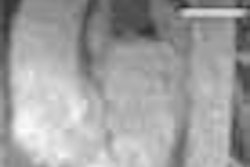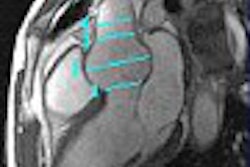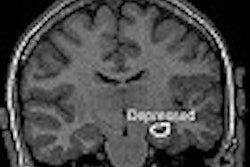VIENNA - It’s now a given that plain radiographs are no match for the challenge of lower back pain. However, MRI fares better only in some regards, according to a new study presented Tuesday at the European Congress of Radiology.
When British patients with lower back pain received an MR exam early on -- prior to seeing a specialist -- their specialists were significantly more confident about a diagnosis or exclusion of disk prolapse at the first visit.
Those patients also had significantly fewer visits to a specialist one year after their initial presentation, according to research conducted at the University of Cambridge in the U.K.
On the other hand, the patients receiving early MRI didn’t report speedier recoveries or any greater satisfaction with their health status than other low back pain patients, said Dr. Adrian K. Dixon, a professor of radiology at Cambridge.
Patients receiving an early MR exam also had more surgery for their lower back pain than the other patients, which may or may not have been beneficial, Dixon noted.
Dixon’s team randomized 167 lower back pain patients being referred by general practitioners to the departments of neurosurgery and rheumatology. Of those patients, 85 received MRI before their first visit to a specialist and 82 did not.
"With regards to qualify of life, (all) patients generally do get better, slightly, slowly, and there was no difference in this gradual improvement between the two groups," Dixon said.
General practitioners in the U.K. have limited access to MRI, but specialists are able to order the exam. Given that some 37% of the control group also ultimately had an MRI at some point during the year, one could assume similar rates of MRI usage among all low back pain patients, Dixon said.
"So you could argue that as MRI avoids radiation, helps clinical diagnosis and management, there are strong arguments for using it at the outset," Dixon said.
Furthermore, he said, immediate MRI "may prevent the late diagnosis of a seriously ill patient," he said, showing the image of a patient with a large malignant schwannoma that, in the absence of MR imaging, could simulate disk herniation.
"I would argue, therefore, that that probably does have an impact on health," Dixon said, "but of course those cases are relatively rare."
By Tracie L. Thompson
AuntMinnie.com staff writer
March 10, 2004
Related Reading
Risk of vertebral deformities increased in women with RA, March 8, 2004
Radiologists and surgeons fractured over vertebroplasty vs. kyphoplasty, November 18, 2003
MRI no better than x-rays in management of low back pain, June 5, 2003
CT-guided spinal intervention alleviates low back pain, May 6, 2003
Copyright © 2004 AuntMinnie.com



















